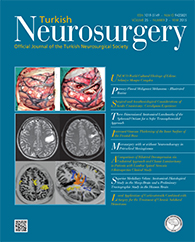2Ataturk University, School of Medicine, Department of Anesthesiology and Reanimation, Erzurum, Turkey
3Ataturk University, School of Medicine, Department of Emergency Medicine, Erzurum, Turkey
4Ataturk University, School of Medicine, Department of Psychiatry, Erzurum, Turkey
5Avrasya Hospital, Department of Neurosurgery, Istanbul, Turkey
6Ataturk University, School of Medicine, Department of Pathology, Erzurum, Turkey DOI : 10.5137/1019-5149.JTN.9964-13.1 AIM: We examined whether there is a relationship between vagal nerve root injury and the severity of respiration disorders associated with subarachnoid hemorrhage (SAH).
MATERIAL and METHODS: This study was conducted on 20 rabbits. Experimental SAH was induced by injecting homologous blood into the cisterna magna. During the experiment, electrocardiography and respiratory rhythms were measured daily. After the experiment, any axonal injury or changes to the arterial nervorums of the vagal nerves were examined. All respiratory irregularities and vagal nerve degenerations were statistically analyzed.
RESULTS: Normal respiration rate, as measured in the control group, was 30±6 bpm. In the SAH-induced group, respiration rates were initially 20±4 bpm, increasing to 40±9/min approximately ten hours later, with severe tachypneic and apneic variation. In histopathological examinations, axon density of vagal nerves was 28500±5500 in both control and sham animals, whereas axon density was 22250±3500 in survivors and 16450±2750 in dead SAH animals. The severity of axonal degeneration of vagal nerves was greater in the six dead animals than in the survivors.
CONCLUSION: If vagal nerves are lesioned, the muscles of respiration are paralyzed and respiratory reflexes are disrupted. That the ischemic and mechanical factors created by SAH cause vagal nerve root injury and respiration disorders may be inevitable and fatal.
Keywords : Injury, Respiration, Rabbit, Subarachnoid hemorrhage, Vagal nerve




